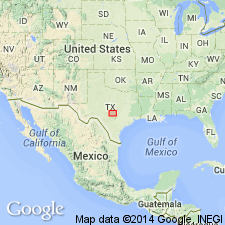
- Usage in publication:
-
- San Saba limestone member*
- Modifications:
-
- Named
- Dominant lithology:
-
- Limestone
- AAPG geologic province:
-
- Llano uplift
Summary:
Named as a member (1 of 5) of Wilberns formation for exposures along and near the San Saba River, northwest of Camp San Saba, McCulloch Co., TX on the Llano uplift. Type section is the exposure on both sides of the Mason-Brady Hwy from the bridge across the San Saba River to a point 0.7 mi north to contact with Threadgill member of Tanyard formation. Overlies Point Peak shale member (named) of Wilberns; lower contact placed above the zone of stromatolitic bioherms --which is not continuous, or at top of highest significant shale. Some of the bioherm masses are as much as 80 ft-thick. Is replaced eastward by Pedernales dolomite member of Wilberns. Sedimentation was continuous across the San Saba-Threadgill boundary. At type, lower 200 ft of member is granular limestone, overlain in sequence by 60 ft of very fine- to coarse-grained, brown to gray, limestone with trilobite hash and some specks of glauconite, and 140 ft of yellow- to buff-weathering gray, microgranular to coarse-grained limestone with pelletal bodies. Upper 140 ft is ledgy, solution-pitted, has globular glauconite. Some local sandstone development. Averages 280 ft thick. Fossils -trilobites, gastropods. Several occurrences described. Cross sections of Late Cambrian age.
Source: GNU records (USGS DDS-6; Denver GNULEX).
For more information, please contact Nancy Stamm, Geologic Names Committee Secretary.
Asterisk (*) indicates published by U.S. Geological Survey authors.
"No current usage" (†) implies that a name has been abandoned or has fallen into disuse. Former usage and, if known, replacement name given in parentheses ( ).
Slash (/) indicates name conflicts with nomenclatural guidelines (CSN, 1933; ACSN, 1961, 1970; NACSN, 1983, 2005, 2021). May be explained within brackets ([ ]).

